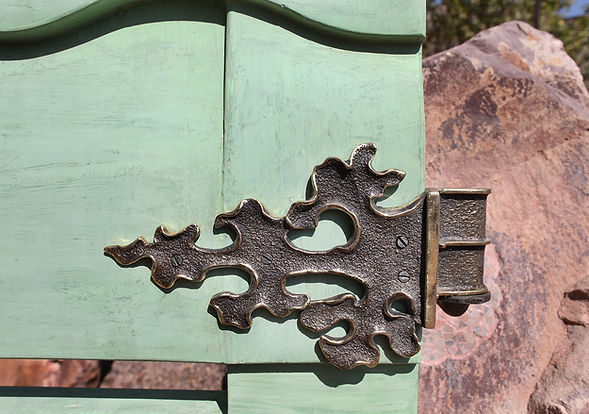GATES
There are several entrances into the Park and we wanted the main gateway into our Visitors Centre to be like an iconic 'sign' with a form and colour that said something subliminal like: ‘This kind of gate, wherever you find it, is a way into the Park’.
Golak has this eccentric but entirely credible theory that a lot of medieval stone carving – of the kind one sees inside the Fort, for instance – could well have been a ‘translation’ of originally wooden carving into stone.
It then became a question of looking for a suitable epitome and we found an attractive stone jaali high up in the Fort that seemed just right.
Making our gate with a wink of deference to a carved motif in Mehrangarh seemed to strike an appropriate note, while the chunkiness of the design rhymed well with the rhyolite blocks on either side.

Sandstone jaali in Zenana Deodi in Mehrangarh
.jpg)

The workshop in Mehrangarh employs freelance carpenters and we were told that Hanuman Jangid was the one best suited to carve out our gate.
(LEFT) Golak's instructions to the Carpenter
We chose to make the gate out of babool (Vachellia nilotica) wood, which is not common in Jodhpur but there’s a thriving trade in babool timber coming in from eastern Rajasthan so it is locally available.
The only timber from the desert that might have fitted the bill in terms of its strength and homogeneity is roheda or desert teak (Tecomella undulata) but it’s not seen in timber markets any more. Too valuable.
We wanted prominent strap-hinges for the Gate and when Jodhpur's bustling antique shops yielded nothing interesting or suitable, I showed Golak a photograph of the intensely lobed leaves of toomba, a desert cucurbit related to watermelons.

Hanuman Jangid did a fine job of carving the motif in wood
Toomba's curlycue leaf seemed a perfect model for a strap-hinge!
.jpg)
_JPG.jpg)
We then went hunting for a metallurgist and almost by chance found an American craftsman settled in Delhi called John Bowman, who deftly ‘translated’ toomba’s lovely leaf-form into brass.
_JPG.jpg)
For the colour of the Gate, we wanted to achieve a particular shade of blue-green – a pale firoza or turquoise – that we’d noticed and envied on several doorways in Jodhpur’s old precincts.

.jpg)
The pale firoza Gate of the Visitors Centre on a day when it's threatening to rain

Three years later, Golak returned to Jodhpur to create another entrance to a segment of the Park that was called 'Jaswant Thada'.



We had come across an interesting rock formation of 'schist' not far from Jodhpur and decided to create the gate-wall using schist the same way it is used to make rural homes near Barr (where schist is mined).
The structure of a rock, the way it shears and splits, determines the form of stone walls — especially dry stone walls — and we were immediately struck by how expessively these schistose walls spoke about the nature of the material.
Unlike sandstone or rhyolite, schist is a metamorphic rock (formed under heat and pressure) made up of thin sheets of clay minerals pressed together like the pages of a book. It needs little effort to split or pull schist apart into iregular plates. People who live within a few miles of Barr make excellent use of
this property in making the walls
of their houses.
We were still 'celebrating rock'!
.jpg)
.jpg)
We repeated the design of the wooden Gate and then added a Chinese-style 'toran' on top, as support for creepers.
Soon after we put it up, Bapji or perhaps Maharani Sahib, sent a message that the gate wasn’t looking ‘quite right’ and when we thought about it, we felt they were quite right!
So we decided to place two irregular blocks of schist over the gateposts instead. Probably not the best idea we've had, perhaps, but...
_JPG.jpg)

The 'teeth' on top of the wall are only a slight variation of a coping we have seen in Jodhpur city.
We used the gaps between the teeth to plant Oropetium grass in. It didn't quite 'take' as well as we hoped and now we've just left it as it is.
_JPG.jpg)
Gates done...
Time to Do Some Gardening!